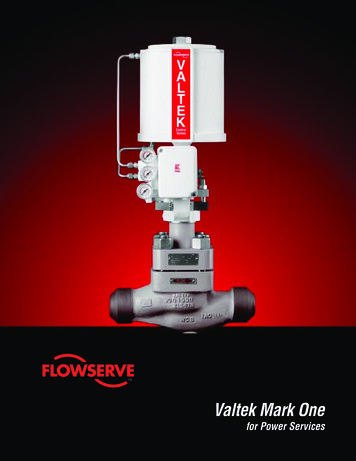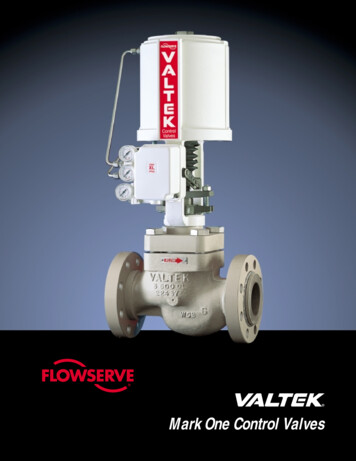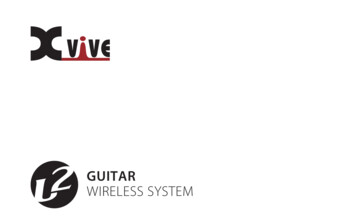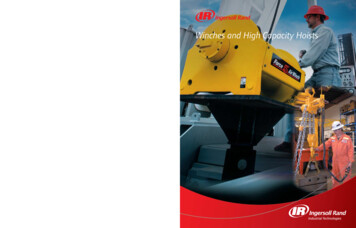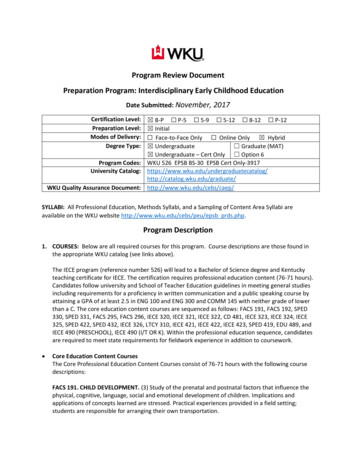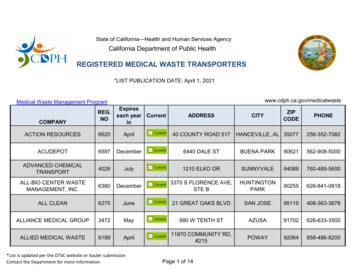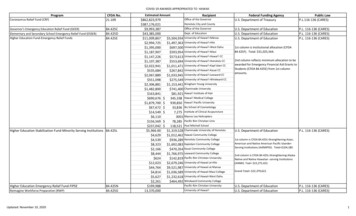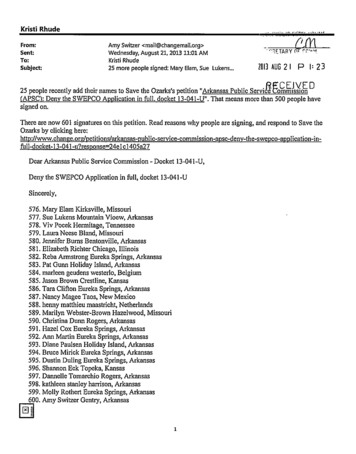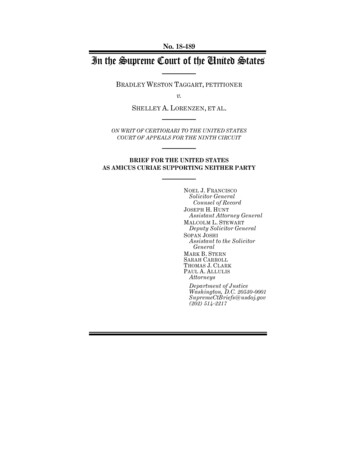
Transcription
No. 18-489In the Supreme Court of the United StatesBRADLEY WESTON TAGGART, PETITIONERv.SHELLEY A. LORENZEN, ET AL.ON WRIT OF CERTIORARI TO THE UNITED STATESCOURT OF APPEALS FOR THE NINTH CIRCUITBRIEF FOR THE UNITED STATESAS AMICUS CURIAE SUPPORTING NEITHER PARTYNOEL J. FRANCISCOSolicitor GeneralCounsel of RecordJOSEPH H. HUNTAssistant Attorney GeneralMALCOLM L. STEWARTDeputy Solicitor GeneralSOPAN JOSHIAssistant to the SolicitorGeneralMARK B. STERNSARAH CARROLLTHOMAS J. CLARKPAUL A. ALLULISAttorneysDepartment of JusticeWashington, D.C. 20530-0001SupremeCtBriefs@usdoj.gov(202) 514-2217
QUESTION PRESENTEDWhether, under the Bankruptcy Code, a creditor’ssubjective good-faith belief that the discharge injunction does not apply precludes a finding of civil contempt.(I)
TABLE OF CONTENTSPageInterest of the United States. 1Statement . 2Summary of argument . 9Argument:A creditor’s subjective good faith does not preclude afinding of civil contempt, but civil-contempt remediesare not available if there is an objectively fair ground ofdoubt about whether the creditor’s conduct violates adischarge order . 13A. Traditional principles governing injunctive reliefapply to the enforcement of discharge ordersentered in bankruptcy cases . 13B. The court of appeals erred in holding that acreditor’s unreasonable good-faith belief that itscollection efforts are lawful precludes theimposition of contempt sanctions. 21C. This Court should not adopt petitioner’s proposedrule . 24D. The Court should vacate the judgment below andremand the case to allow the court of appeals toapply the correct standard in the first instance . 29Conclusion . 32TABLE OF AUTHORITIESCases:Abbott Labs. v. Unlimited Beverages, Inc.,218 F.3d 1238 (11th Cir. 2000) . 20Alyeska Pipeline Serv. Co. v. Wilderness Soc’y,421 U.S. 240 (1975). 28Axia NetMedia Corp. v. Massachusetts Tech. ParkCorp., 889 F.3d 1 (1st Cir. 2018) . 17Ben Franklin Hotel Assocs., In re, 186 F.3d 301(3d Cir. 1999) . 20(III)
IVCases—Continued:PageCFE Racing Prods., Inc. v. BMF Wheels, Inc.,793 F.3d 571 (6th Cir. 2015) . 17, 22California Artificial Stone Paving Co. v. Molitor,113 U.S. 609 (1885). passimCanning, In re, 706 F.3d 64 (1st Cir. 2013) . 4Chambers v. Nasco, Inc., 501 U.S. 32 (1991) . 4, 26Chao v. Gotham Registry, Inc., 514 F.3d 280(2d Cir. 2008) . 20City of New York v. Mickalis Pawn Shop, LLC,645 F.3d 114 (2d Cir. 2011) . 17Cox v. Zale Del., Inc., 239 F.3d 910 (7th Cir. 2001) . 14Cutter v. Wilkinson, 544 U.S. 709 (2005) . 12, 31First State Bank of Roscoe v. Stabler, 914 F.3d 1129(8th Cir. 2019) . 22Food Lion, Inc. v. United Food & CommercialWorkers Int’l Union, AFL-CIO-CLC,103 F.3d 1007 (D.C. Cir. 1997) . 22Gascho v. Global Fitness Holdings, LLC, 875 F.3d795 (6th Cir. 2017), cert. denied, 138 S. Ct. 2576(2018) . 17Gervin, In re, 300 Fed. Appx. 293 (5th Cir. 2008) . 20Gompers v. Bucks Stove & Range Co., 221 U.S. 418(1911) . 22, 31Hardy, In re, 97 F.3d 1384 (11th Cir. 1996). 4, 5, 8, 24Hutto v. Finney, 437 U.S. 678 (1978) . 28International Longshoremen’s Ass’n v. PhiladelphiaMarine Trade Ass’n, 389 U.S. 64 (1967) . 15Jove Eng’g, Inc. v. IRS, 92 F.3d 1539(11th Cir. 1996) . 17, 18Katchen v. Landy, 382 U.S. 323 (1966) . 4, 27Latino Officers Ass’n City of N.Y., Inc. v. City ofNew York, 558 F.3d 159 (2d Cir. 2009) . 16
VCases—Continued:PageMcComb v. Jacksonville Paper Co., 336 U.S. 187(1949) . 11, 22, 25, 26Michaelson v. United States ex rel. Chicago, St.Paul, Minneapolis & Omaha Ry. Co., 266 U.S. 42(1924) . 14Morissette v. United States, 342 U.S. 246 (1952) . 14Northeast Women’s Ctr., Inc. v. McMonagle,939 F.2d 57 (3d Cir. 1991) . 20Pertuso v. Ford Motor Credit Co., 233 F.3d 417(6th Cir. 2000) . 14Robin Woods Inc. v. Woods, 28 F.3d 396(3d Cir. 1994) . 22, 23Schmidt v. Lessard, 414 U.S. 473 (1974) . 10Sekhar v. United States, 570 U.S. 729 (2013) . 14Sherwood Park Bus. Ctr., LLC v. Taggart,341 P.3d 96 (Or. App. 2014). 7Shillitani v. United States, 384 U.S. 364 (1966) . 22, 31Spencer, In re, 868 F.3d 748 (8th Cir. 2017) . 20Swift & Co. v. United States, 196 U.S. 375 (1905) . 16Tennessee Student Assistance Corp. v. Hood,541 U.S. 440 (2004). 27TiVo Inc. v. EchoStar Corp., 646 F.3d 869(Fed. Cir. 2011) . 16United States v. Saccoccia, 433 F.3d 19(1st Cir. 2005) . 16, 17United States v. Stitt, 139 S. Ct. 399 (2018) . 31United Student Aid Funds, Inc. v. Espinosa,559 U.S. 260 (2010). 3Williams, In re, 438 B.R. 679 (B.A.P. 10th Cir. 2010) . 27Ybarra, In re, 424 F.3d 1018 (2005), cert. denied,547 U.S. 1163 (2006). 6, 12, 30
VICases—Continued:PageYoung v. United States ex rel. Vuitton et Fils S. A.,481 U.S. 787 (1987). 13Zilog, Inc., In re, 450 F.3d 996 (9th Cir. 2006) . 4, 14Statutes and rules:Bankruptcy Code:Ch. 1, 11 U.S.C. 101 et seq :11 U.S.C. 101(5)(A) . 3011 U.S.C. 105 . 4, 511 U.S.C. 105(a) . 4, 13, 14, 2311 U.S.C. 106(a)(1) . 4Ch. 3, 11 U.S.C. 301 et seq:11 U.S.C. 307 . 111 U.S.C. 362 . 511 U.S.C. 362(a) . 511 U.S.C. 362(k) . 10, 2311 U.S.C. 362(k)(1) . 5Ch. 5, 11 U.S.C. 501 et seq:11 U.S.C. 523(a) . 2, 1911 U.S.C. 523(a)(1)-(19) . 211 U.S.C. 523(a)(1) . 211 U.S.C. 523(a)(1)(C) . 211 U.S.C. 523(a)(2) . 3, 19, 2611 U.S.C. 523(a)(4) . 3, 19, 2611 U.S.C. 523(a)(6) . 3, 19, 2611 U.S.C. 523(a)(7) . 211 U.S.C. 523(a)(8) . 2, 2711 U.S.C. 523(a)(11) . 211 U.S.C. 523(a)(12) . 211 U.S.C. 523(a)(13) . 211 U.S.C. 523(a)(14B) . 2
VIIStatutes and rules—Continued:Page11 U.S.C. 523(a)(18) . 211 U.S.C. 523(c)(1) . 2, 1911 U.S.C. 523(d) . 2811 U.S.C. 524 . 4, 5, 13, 1411 U.S.C. 524(a)(2) . passimCh. 7, 11 U.S.C. 701 et seq . 2, 3, 6, 3011 U.S.C. 727 . 2, 3011 U.S.C. 727(b) . 30Ch. 11, 11 U.S.C. 1101 et seq . 211 U.S.C. 1141 . 2Ch. 12, 11 U.S.C. 1201 et seq . 211 U.S.C. 1228 . 2Ch. 13, 11 U.S.C. 1301 et seq . 2, 2011 U.S.C. 1328 . 2Fair Labor Standards Act of 1938, 29 U.S.C. 201et seq. . 25Internal Revenue Code (26 U.S.C.):§ 7433(e). 10, 23§ 7433(e)(2)(A) . 5Internal Revenue Service Restructuring and ReformAct of 1998, Pub. L. No. 105-206, § 3102(c)(1),112 Stat. 730-731 (26 U.S.C. 7433(e)(1)) . 528 U.S.C. 581-589a . 128 U.S.C. 1334(b) . 3, 27Fed. R. Bankr. P.:Rule 4007 . 3Rule 9009(a) . 3Rule 9014(c). 17Rule 9020 . 4, 17
VIIIRules—Continued:PageFed. R. Civ. P.:Rule 8(c)(1) advisory committee’s note(2010 Amendment) . 27Rule 65(d) . 16, 17, 18Rule 65(d)(1)(B) . 16Rule 65(d)(1)(C) . 16Miscellaneous:5 Collier on Bankruptcy (16th ed. 2013) . 302 James L. High, A Treatise on the Law ofInjunctions (4th ed. 1905) . 22Official Bankruptcy Form No. 18: Discharge ofDebtor (Dec. 1, 2007), www.uscourts.gov/sites/default/files/b 018 1207.pdf . 3, 30Official Bankruptcy Form No. 318: Order of Discharge (Dec. 1, 2015), www.uscourts.gov/sites/default/files/form b318 0.pdf . 3, 4
In the Supreme Court of the United StatesNo. 18-489BRADLEY WESTON TAGGART, PETITIONERv.SHELLEY A. LORENZEN, ET AL.ON WRIT OF CERTIORARI TO THE UNITED STATESCOURT OF APPEALS FOR THE NINTH CIRCUITBRIEF FOR THE UNITED STATESAS AMICUS CURIAE SUPPORTING NEITHER PARTYINTEREST OF THE UNITED STATESThe question presented in this case concerns the circumstances under which a creditor may be subject tocivil-contempt sanctions for attempting to collect a debtafter the entry of a discharge order under the Bankruptcy Code. The Attorney General appoints UnitedStates Trustees to supervise the administration ofbankruptcy cases and trustees throughout the country.28 U.S.C. 581-589a. United States Trustees “may raiseand may appear and be heard on any issue in any caseor proceeding under” the Bankruptcy Code. 11 U.S.C.307. The United States also is the Nation’s largest creditor. Federal agencies often seek to recover debts frompersons who have filed for bankruptcy, and the application of the discharge order to debts owed to the govern-(1)
2ment is not always readily apparent. The question presented therefore is of substantial importance to theUnited States.STATEMENT1. a. When a debtor successfully completes itsbankruptcy case, the bankruptcy court typically entersa discharge order releasing the debtor from liability formost pre-bankruptcy debts. See 11 U.S.C. 727 (Chapter7), 1141 (Chapter 11), 1228 (Chapter 12), and 1328(Chapter 13). A discharge order “operates as an injunction against the commencement or continuation of anaction, the employment of process, or an act, to collect,recover or offset any such [discharged] debt as a personal liability of the debtor.” 11 U.S.C. 524(a)(2).Although most pre-bankruptcy debts are dischargedby such an order, certain debts are not, see 11 U.S.C.523(a)(1)-(19), including various categories of debtscommonly held by the government, e.g., 11 U.S.C.523(a)(1), (7), (8), (11), (12), (13), (14B), and (18). Oftenit is clear whether a particular debt falls into one ofthese exceptions to discharge. There rarely is anydoubt, for example, whether a debt is one for “paymentof an order of [criminal] restitution.” 11 U.S.C.523(a)(13). Other times it is not so clear, as with taxdebts “with respect to which the debtor made a fraudulent return or willfully attempted in any manner toevade or defeat such tax.” 11 U.S.C. 523(a)(1)(C).Whether a debtor “willfully attempted” to “evade or defeat” a tax can be a hotly contested question.With respect to some of the potentially nondischargeable debts listed in Section 523(a), the Codestates that a particular debt will be discharged unless aparty obtains an advance determination to the contraryfrom the bankruptcy court. 11 U.S.C. 523(c)(1); see
311 U.S.C. 523(a)(2), (4), and (6). And for student-loandebts, a debtor must file an adversary complaint in thebankruptcy case, and obtain a determination that thedebt is dischargeable, or the debt will not be discharged. See United Student Aid Funds, Inc. v. Espinosa, 559 U.S. 260, 268-269 (2010). With respect to mosttypes of debts, however, no advance determination as todischargeability is necessary, and the question whethera particular debt has been discharged is left for futureresolution. Cf. Fed. R. Bankr. P. 4007. That resolutionneed not occur in the bankruptcy court. Rather, othercourts, including state courts, have concurrent jurisdiction to resolve dischargeability disputes—as, for instance, when discharge is raised as a defense in a statecourt collection action. See 28 U.S.C. 1334(b) (vestingdistrict courts with “original but not exclusive jurisdiction of all civil proceedings arising under title 11”).Dischargeability disputes arise most frequently inChapter 7 cases. Most Chapter 7 cases are resolved relatively quickly, and the typical discharge order simplyidentifies the debtor and states that a “discharge under11 U.S.C. § 727 is granted.” Official Bankruptcy FormNo. 318, at 1, www.uscourts.gov/sites/default/files/form b318 0.pdf; see Official Bankruptcy Form No.18 (superseded Dec. 1, 2015), www.uscourts.gov/sites/default/files/b 018 1207.pdf; see also Fed. R. Bankr. P.9009(a). Rather than identify the particular debts of thedebtor that are (or are not) discharged, the standardChapter 7 discharge order typically includes an“[e]xplanation” stating that “[m]ost debts are coveredby the discharge, but not all,” and that “[b]ecause thelaw is complicated, you should consult an attorney to determine the exact effect of the discharge in this case.”Official Bankruptcy Form No. 318, at 1-2 (emphasis
4omitted); see id. at 2 (listing “[e]xamples of debts thatare not discharged”). A summary discharge of this typeis consistent with the need “ ‘to secure a prompt and effectual administration and settlement of the estate of allbankrupts within a limited period,’ ” which is “a chiefpurpose of the bankruptcy laws.” Katchen v. Landy,382 U.S. 323, 328 (1966) (citation omitted).b. Although Section 524 states that a discharge order “operates as an injunction” against any attempt tocollect a discharged debt, 11 U.S.C. 524(a)(2), it does notprescribe a remedy for violations of the discharge injunction. Section 105, however, authorizes a bankruptcy court to “issue any order, process, or judgmentthat is necessary or appropriate to carry out the provisions of ” the Bankruptcy Code. 11 U.S.C. 105(a).Courts have read Sections 105(a) and 524(a)(2),taken together, as authorizing civil-contempt actionsagainst creditors who attempt to collect dischargeddebts. E.g., In re Canning, 706 F.3d 64, 69 (1st Cir.2013); In re Zilog, Inc., 450 F.3d 996, 1007 (9th Cir.2006); see Fed. R. Bankr. P. 9020 (recognizing thatbankruptcy courts may conduct contempt proceedings).Since the United States has waived its sovereign immunity for purposes of Section 105, the power to imposecivil-contempt remedies generally extends to governmental creditors. See 11 U.S.C. 106(a)(1). Some courtshave stated that a bankruptcy court also has inherentpower to enforce a discharge injunction through civilcontempt sanctions, but that such power should be exercised with “restraint” and only when the creditor engages in “bad-faith conduct.” In re Hardy, 97 F.3d1384, 1389 (11th Cir. 1996) (quoting Chambers v. Nasco,Inc., 501 U.S. 32, 44, 50 (1991)).
5Two related provisions bear mention. First, underSection 362, the filing of a petition for bankruptcy “operates as a stay” of most collection or enforcement efforts against the debtor during the pendency of thebankruptcy case. 11 U.S.C. 362(a). Unlike with the discharge injunction, the Bankruptcy Code prescribes aspecific remedy for certain violations of the automaticstay: “an individual injured by any willful violation of[the automatic] stay” generally “shall recover actualdamages, including costs and attorneys’ fees, and, in appropriate circumstances, may recover punitive damages.” 11 U.S.C. 362(k)(1).Second, Congress amended the Internal RevenueCode in 1998 to provide that, if an IRS officer or employee “willfully violates” either the automatic stay orthe discharge injunction, the affected taxpayer “maypetition the bankruptcy court to recover damagesagainst the United States.” Internal Revenue ServiceRestructuring and Reform Act of 1998, Pub. L. No. 105206, § 3102(c)(1), 112 Stat. 730-731 (26 U.S.C. 7433(e)(1)).With respect to discharge violations, “such petitionshall be the exclusive remedy for recovering damages”against the IRS. 26 U.S.C. 7433(e)(2)(A).Both of these provisions require a “willful” violationof the automatic stay or discharge injunction before acourt may award damages to the debtor. 11 U.S.C.362(k)(1); see 26 U.S.C. 7433(e)(1). Although neitherSection 105 nor Section 524 uses that term, some courtshave said that the imposition of civil-contempt sanctionsunder Section 105 likewise requires a “willful” violationof the discharge injunction. E.g., Hardy, 97 F.3d at1390; Pet. App. 58a (bankruptcy-court decision below).2. a. This case arises out of a business dispute. Petitioner o
(202) 514-2217 (I) QUESTION PRESENTED . Whether, under the Bankruptcy Code, a creditor’s . Food Lion, Inc. v. United Food & Commercial Workers Int’l Union, AFL-CIO-CLC, 103 F.3d 1007 (D.C. Cir. 1997


